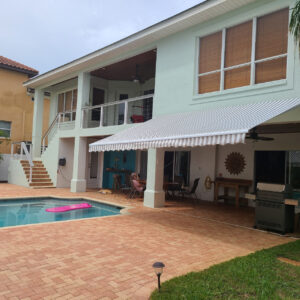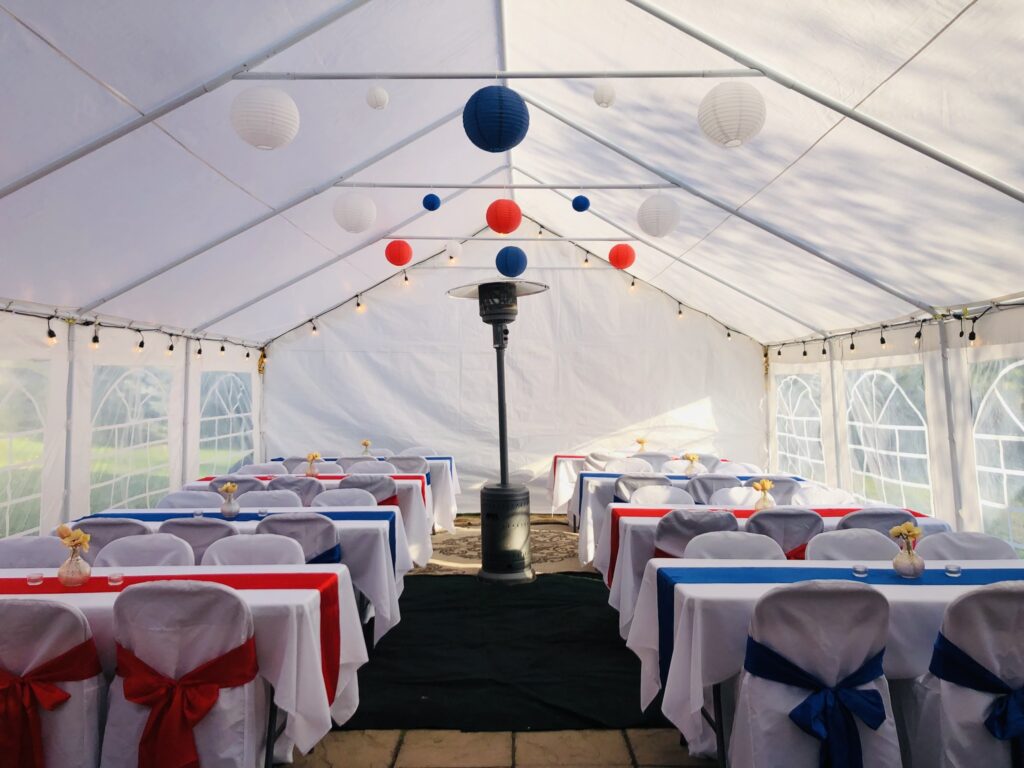When it comes to enhancing your outdoor space and seeking respite from the sun, awnings and canopies are two popular options. These versatile shade solutions not only offer protection from the elements but also add style and functionality to your outdoor living space. However, understanding the differences between awnings and canopies is crucial in making an informed decision. In this complete guide, we’ll compare and contrast awnings and canopies, highlighting their unique features, benefits, and ideal applications. So, let’s dive into the awning vs. canopy debate and uncover which option suits your needs best!
Understanding the Difference Awnings and Canopies
Before delving into the comparison, let’s establish a clear understanding of awnings and canopies:
Awnings

Outdoor awnings are retractable or fixed structures made from various materials such as fabric, metal, or aluminum. They are typically attached to the exterior walls of buildings, extending outward to provide shade over windows, doors, patios, or decks. Awnings can be manually operated or motorized for convenient control.
Canopies
Canopies, on the other hand, are freestanding structures that provide overhead coverage without relying on the support of a building. They are commonly seen as temporary shelters, often used at outdoor events, markets, or as carports. Canopies are available in various sizes, shapes, and materials, including fabric covers and metal frames.
Design and Structure
Awnings
Awnings are designed to blend seamlessly with the architecture of a building. In fact, many homeowners choose an awning when designing a patio or outdoor space. They come in a wide range of styles, including traditional, contemporary, or modern, allowing you to choose the one that complements your aesthetic preferences. Awnings can be customized to fit specific dimensions and can feature various shapes such as dome, quarter barrel, or traditional straight-edged designs.
Canopies
Canopies are versatile structures that offer flexibility in terms of design and placement. They can be easily relocated and come in a multitude of shapes and sizes, from small pop-up canopies to large event tents. Canopies are often supported by a metal frame or poles, providing stability and durability.

Installation and Portability
Awnings
Awnings are typically installed as permanent fixtures attached to the exterior of a building. While retractable awnings can be adjusted or retracted as needed, fixed awnings remain in place throughout the year. Professional installation is recommended for ensuring proper attachment and structural integrity.
Canopies
Canopies are known for their portability, making them a convenient option for temporary shade needs. They can be set up and taken down quickly, offering flexibility and versatility. Canopies are popular for outdoor events, as they provide shade and shelter without the need for permanent structures.
Purpose and Functionality
Awnings
Awnings excel at providing shade and protection from direct sunlight. They reduce the amount of heat entering the building, thus lowering energy costs for cooling. Awnings also shield windows and doors from rain, preventing water damage. Additionally, retractable awnings offer the flexibility to adjust the shade coverage as desired, allowing you to adapt to changing weather conditions.
Canopies
Canopies serve multiple purposes, offering shade and shelter for various outdoor activities. They are ideal for creating temporary seating areas, outdoor event spaces, or carports. Canopies provide protection from sun, rain, and other weather elements, ensuring a comfortable and enjoyable experience in any outdoor setting.
Durability and Maintenance
Awnings

Awnings are designed to withstand outdoor conditions and are built to be durable. The choice of materials, such as weather-resistant fabric or sturdy metal frames, contributes to their longevity. Regular cleaning and maintenance, including removing debris and inspecting for any damage, will help prolong their lifespan.
Canopies
Canopies are available in a wide range of materials, each with varying degrees of durability. Metal frame canopies are generally sturdier and more resistant to wind and adverse weather conditions, while fabric canopies may require more care and occasional replacement. Proper maintenance, such as ensuring secure anchoring and protecting against UV rays, can extend the lifespan of a canopy.
Price
Awnings
Awnings generally tend to be pricier compared to canopies due to their permanent or semi-permanent nature and the additional features they offer. Here are some factors that influence the price of awnings:
- Type of Awning: There are several types of awnings, such as retractable awnings, fixed awnings, or motorized awnings. Retractable awnings tend to be more expensive than fixed awnings due to their added functionality and convenience.
- Size and Coverage: Larger awnings that provide extensive coverage will typically come at a higher price. The size of the area you want to shade will impact the cost of the awning.
- Material Quality: Awnings can be made from various materials, including fabric, metal, or aluminum. The quality and durability of the chosen material affect the price. High-quality fabrics, such as acrylic or woven polyester, are generally more expensive but offer enhanced longevity. ALEKO’s awnings use a specialized PVC (polyvinyl chloride) fabric that is resistant to harmful UV ray heat, water, mildew, stains, and fading. ALEKO awning frames are made from powder-coated steel that protects the fabric while the awning is retracted.
- Mechanism and Controls: If you opt for a motorized or remote-controlled awning, the additional mechanisms and controls will contribute to the overall cost. These advanced features offer convenience and ease of use. ALEKO motorized retractable awnings come with a 1-click remote control to open and close the awning as needed. A hand crank is also included to manually open and close the awning if electricity isn’t available or if your remote is out of battery.
- Customization: Customized awnings, designed to fit specific dimensions or match the aesthetics of your property, may come at a higher price compared to standard options. You can also purchase awnings that come with LED lights so you can have the perfect ambiance during the evening.
- Installation: Professional installation of awnings ensures proper attachment and structural integrity but may incur additional costs. Installation charges can vary depending on the complexity of the project and the location of your property.
Canopies

Canopies are generally more affordable compared to awnings, primarily due to their temporary and portable nature. The price of canopies can vary depending on factors such as size, material, construction quality, and additional features. Here are some factors that impact the cost of canopies:
- Size and Design: Larger canopies with a greater coverage area tend to be more expensive than smaller ones. Similarly, complex designs and customizations may increase the price.
- Materials: Canopies are available in various materials, including polyester, vinyl, and canvas. The type of material you choose can influence the cost. Polyester canopies are generally more affordable, while high-quality canvas or vinyl canopies may come at a higher price point.
- Frame Quality: Canopies with sturdy metal frames are typically more expensive than those with lightweight frames. The durability and stability provided by a robust frame contribute to the overall cost.
- Additional Features: Some canopies come with additional features such as sidewalls, windows, mosquito netting, or built-in lighting systems. These added functionalities can impact the price of the canopy.
- Brand and Supplier: The reputation of the brand and the supplier you choose can also affect the cost. Established brands or specialized suppliers may offer higher-priced canopies due to factors such as quality assurance and customer support.
Permits and Regulations
When considering the installation of awnings or canopies, it’s crucial to be aware of any permits or regulations that may apply to your specific location. Local building codes and regulations can vary, so it’s important to research and comply with the requirements in your area. Here are some key points to consider.
Local Building Codes
Contact your local building or planning department to inquire about any regulations or permits necessary for installing awnings or canopies. They will provide you with specific guidelines regarding setbacks, height restrictions, and structural requirements. Adhering to these codes ensures that your installation meets safety standards and avoids potential legal issues.
Homeowner’s Association (HOA) Guidelines
If you live in a community governed by a homeowner’s association, it’s essential to review their guidelines and restrictions before installing an awning or canopy. Some HOAs have specific rules regarding the type, color, and placement of shade structures to maintain a cohesive aesthetic within the neighborhood. Obtain approval from the HOA before proceeding with your installation.
Historic Districts or Conservation Areas
If your property is located in a historic district or a designated conservation area, there may be additional regulations to consider. These areas often have strict guidelines to preserve the architectural integrity and historical significance of the neighborhood. Obtain the necessary approvals from the relevant authorities to ensure compliance.
Permit Requirements
Depending on the size, location, and type of awning or canopy you plan to install, you may need to obtain a permit from your local municipality. Permits are typically required for permanent structures or installations that involve structural modifications. The permit process ensures that the installation meets safety standards and complies with building codes.
Professional Assistance
Consulting with a professional awning or canopy installer can be beneficial when navigating the permit and regulation requirements. They are experienced in dealing with local authorities and can guide you through the process, ensuring compliance and a smooth installation.
Remember, it is your responsibility as a property owner to obtain the necessary permits and comply with local regulations. Failure to do so may result in fines, forced removal of the structure, or other legal consequences. Taking the time to research and comply with the applicable regulations will help ensure a hassle-free and legally compliant installation.
Wrapping Up
As you weigh the options of awnings vs. canopies, consider your specific needs, aesthetic preferences, and functionality requirements. Awnings are excellent for providing shade and protection to windows, doors, and outdoor living spaces, with the added benefit of adjustable coverage. Canopies, on the other hand, offer portable and flexible shelter solutions for various outdoor events and activities.
Ultimately, the choice between awnings and canopies depends on your intended purpose, desired aesthetics, and practical considerations. Whether you seek a permanent structure that seamlessly integrates with your building or a portable canopy for versatile outdoor use, both options have their unique advantages. By understanding the differences between awnings and canopies, you can confidently select the shade solution that best suits your needs, adding comfort, style, and functionality to your outdoor spaces.






